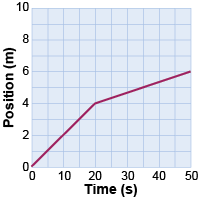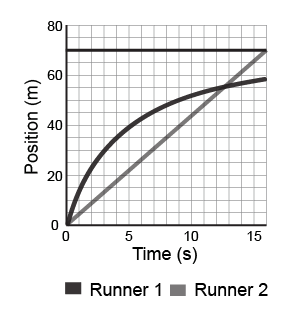- A position versus time graph represents the motion of two objects. The line for object one has a steep slope and the line for object two has a shallow slope. Which object is moving faster?
- What physical quantity is represented by area on a velocity versus time graph?
- Your friend took a walk through a maze. She wrote down exactly how far she traveled along each straight path in the maze and at what times she turned. She always walked with a steady velocity along any straight path and only changed velocities when she turned.
- Explain how you would use her data to find her instantaneous velocity at any single point in the maze. Include the equation you would use.
- Explain how you would use her data to find her average velocity. Include the equation you would use.
- Kristie walks once around a large circle at a constant speed. What is her average velocity for the whole walk? Explain using equations. Is Kristie’s instantaneous velocity constant? Explain this second part in words.
 Scott is chasing Damian along a track. Consider two frames of reference: Damian’s moving frame of reference and the ground’s fixed frame of reference. Is Scott’s speed faster or slower in Damian’s reference frame compared to the ground’s frame? Scott is chasing Damian along a track. Consider two frames of reference: Damian’s moving frame of reference and the ground’s fixed frame of reference. Is Scott’s speed faster or slower in Damian’s reference frame compared to the ground’s frame?

- Without looking at the numbers, does the graph above show a greater speed at 10 s or at 40 s?
How can you tell?
- The area on the velocity versus time graph represents distance. What does the area on a position versus time graph represent?

- Which graph above shows the least amount of movement?
 Describe three different ways you can travel 100 m in 10 s. Each different way must specify speed(s) and time(s). Describe three different ways you can travel 100 m in 10 s. Each different way must specify speed(s) and time(s).
| | - Which of the following sentences best matches the meaning of the equation d = vt?
- The speed is the distance divided by the time.
- The time is the distance divided by the speed.
- The distance is the speed multiplied by the time.
- The distance is the speed divided by the time.
 What does the slope in a position versus time graph represent? What does the slope in a position versus time graph represent?
 What can you say about the shape of a position versus time graph representing accelerated motion? What can you say about the shape of a position versus time graph representing accelerated motion?
 How do you find distance traveled on a velocity versus time graph? How do you find distance traveled on a velocity versus time graph?
 Why is the slope of a distance versus time graph equal to speed? Why is the slope of a distance versus time graph equal to speed?
 A position–time graph of Liz’s trip to Boston shows a flat line starting at x = 3 hr and ending at x = 5 hr. What does this mean? A position–time graph of Liz’s trip to Boston shows a flat line starting at x = 3 hr and ending at x = 5 hr. What does this mean?
 Janet is pulled over by a police officer for going faster than the speed limit. Janet, a high school physics student, argues that she didn’t violate the law because her average velocity over the course of the last five miles was under the speed limit. The officer still gives Janet a ticket. What was the mistake in Janet’s argument? Janet is pulled over by a police officer for going faster than the speed limit. Janet, a high school physics student, argues that she didn’t violate the law because her average velocity over the course of the last five miles was under the speed limit. The officer still gives Janet a ticket. What was the mistake in Janet’s argument?

 This position versus time graph shows a famous, mythic race. Can you tell which one? Explain and include a description of the race in your answer. This position versus time graph shows a famous, mythic race. Can you tell which one? Explain and include a description of the race in your answer.
 Give an example of a situation where an object moves in two or three dimensions but its motion can be characterized in one dimension? Give an example of a situation where an object moves in two or three dimensions but its motion can be characterized in one dimension?
|

